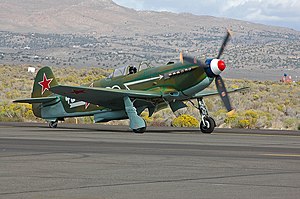Yakovlev Yak-9
| Yak-9 | |
|---|---|
 |
|
| An airworthy replica of Yak-9U (Yak-9UM) at Reno, USA | |
| Role | Fighter |
| National origin | Soviet Union |
| Manufacturer | Yakovlev OKB |
| Designer | Alexander Sergeevich Yakovlev |
| First flight | Summer 1942 |
| Introduction | October 1942 |
| Primary user | Soviet Air Force |
| Produced | 1942–1948 |
| Number built | 16,769 |
| Developed from | Yakovlev Yak-1 |
The Yakovlev Yak-9 was a single-engine fighter aircraft used by the Soviet Union in World War II and after. Fundamentally a lighter development of the Yak-7 with the same armament, it arrived at the front at the end of 1942. The Yak-9 had a lowered rear fuselage decking and all-around vision canopy. Its lighter airframe gave the new fighter a flexibility that previous models had lacked. The Yak-9 was the most mass-produced Soviet fighter of all time. It remained in production from 1942 to 1948, with 16,769 built (14,579 during the war). Towards the end of the war, the Yak-9 was the first Soviet aircraft to shoot down a Messerschmitt Me 262 jet. Following World War II it was used by the North Korean Air Force during the Korean War.
The Yak-9 represented further development of the successful Yakovlev Yak-7 fighter, a production version of the lightened Yak-7DI, taking full advantage of the combat experience with its predecessor. Greater availability of duralumin allowed for lighter construction which in turn permitted a number of modifications to the basic design.
Yak-9 variants carried two different wings, five different engines, six different fuel tank combinations and seven types of armament configurations. In December 1943, it became possible to install the more powerful M-107 engine on a new Yak-9U airframe: the engine mounting was new with individual faired exhaust pipes; fuselage structure and wings were made of metal and the whole aircraft was covered with a Bakelite skin . Fuel capacity was increased to 400 l (106 US gal). In order to re-balance the model, the wing was repositioned four inches forward and in order to improve pitch control, the horizontal tail surfaces were slightly reduced. The rear part of the canopy was lengthened and the antenna cable was moved inside it. Usual armament was a 20 mm (0.79 in) ShVAK cannon with 120 rounds firing through a hollow propeller shaft and a 12.7 mm (0.50 in) UBS machine gun with 170 rounds.
...
Wikipedia
